 |
 |
|
Gassaway
|
 |
|
Dundon
|
 |
Ansted
Gauley Bridge
Glen Jean
Mt. Hope
Thurmond |
 |
|
Alum Creek
Branchland
|
 |
|
Logan
|
 |
|
Davy
Iaeger
Kimball
Roderick
Twin Branch
War
Welch
|
 |
|
Historic Matewan
Williamson
Dingess
Red Jacket
|
 |
|
Itmann
Mullens
Oceana
Sabine
Wyco
Wyoming
|
|
|
|
|
|
|
|
|
|
|
|
HISTORY
|
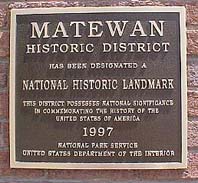 |
MATEWAN HISTORIC DISTRICT: Touring Downtown Matewan is like going back in time to the early 1920s. Nearly all the historic buildings still remain. Matewan's downtown was declared a National Historic Landmark in 1997. Attractions include an audio presentation at the Matewan Massacre site, historic buildings restored to their 1920 appearance. Walking tour brochures are available at the visitors center or by calling (304) 426-4522 or (304) 426-6512.
Click here for more information. |
|
|
|
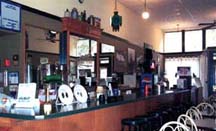 |
Also located in the Matewan Historic District is the one place you will not want to miss - the Matewan Depot Restaurant. The restaurant features numerous historic photos of the community from days gone by including information on the Matewan Massacre and the Hatfield & McCoy Feud.
|
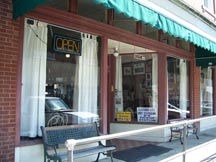 |
|
 |
Surrounding the downtown historic district of Matewan is the floodwall surrounding the downtown historic district. The “Great Wall” of Matewan and its adjacent walking path on the river side of the wall is open year round to visitors.
The walking path allows visitors to study the historic graphics embedded in the floodwall. Completed in 1996 by the U.S. Army Corps of Engineers, the Matewan Floodwall contains monolithic images poured into the concrete wall depicting a time line of Matewan's history.
|
|
|
|
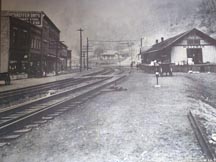 |
MATEWAN MASSACRE
Now a National Historic Landmark, Matewan is well known as the site of a bloody confrontation between townspeople, miners and mine company detectives on May 19, 1920.
|
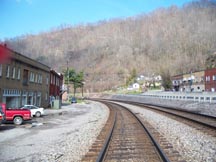 |
|
|
At that time the United Mine Workers of America were attempting to organize the area's coal miners, but those who joined were fired and evicted from their company-owned homes.
In town near the railroad tracks, Chief of Police Sid Hatfield and Mayor Cable Testerman encountered Baldwin-Felts detectives who had been hired to evict miners. After an argument, shots were fired leaving the mayor, seven detectives and two miners dead.
Sid Hatfield emerged as a hero for the miners but was gunned down by retaliating detectives a year later on the McDowell County Courthouse steps in Welch. Union activist Ed Chambers was killed along with Sid. Their deaths triggered many disturbances, including the armed march of miners through the southern coal fields, culminating in the showdown at Blair Mountain in Logan County between miners, operators and federal forces.
An audio presentation of the battle of Matewan can be heard by pushing a button on the wall of the old post office, directly behind the old Matewan Bank building. The 15-minute presentation mixes narrative eyewitness accounts and sound effects to tell the story of what happened in Matewan in the spring of 1920.
The critically acclaimed movie, Matewan, released in 1987 by film maker John Sayles, has brought nationwide attention to the town's fascinating story, promoting an understanding of West Virginia's turbulent past. For more on the Matewan Massacre, click here.
|
|
|
|
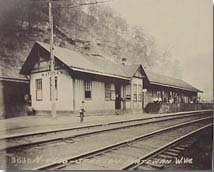 |
MATEWAN TRAIN DEPOT
In 1893, upon completion of a 191-mile coalfield connection of original N&W lines and the newly-acquired Scioto Valley & New England to Columbus, a combined passenger and freight depot of Standard 2nd Class design was constructed at Matewan.
|
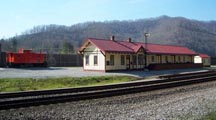 |
|
|
1902-1919. As the surrounding Thacker Coalfield developed (Thacker Coal & Coke, Grapevine Coal Co. and Lynn Coal & Coke and Alma Coal & Coke at Matewan were early operations), a 20 x 24 ft. addition to the wareroom (freight house) was necessary in 1902.
Although Matewan's population at its peak was just 989 residents, the immediate surrounding area was inhabited by about seven thousand people. Serving as the primary billing station and secondary trading center (to Williamson) for the Thacker field, it was necessary to enlarge the Matewan depot warehouse and waiting rooms (extended by another 50 and 12 ft, respectively) in 1916. This was the final configuration as presently represented.
Advancing technology and the demise of railroad passenger service led to many depots being closed across the country. Matewan was no exception, and, after service on the Cavalier was curtailed west of Bluefield in 1960, and the downgraded Powhatan Arrow - once the pride of N&W-made its last stop in 1969, the depot was closed and the building fell into disrepair.
|
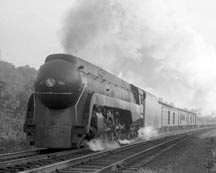 |
Photo of the Cavalier Passenger Train which once made regular runs to Matewan Depot. |
|
| In 2000, Massey Energy rebuilt the depot. It now serves as a museum that includes information and displays on the feud, the Matewan Massacre, the history of coal in the area and more. Call (304) 426-4239 for more information. The 24 x 110 ft. reconstruction is an inch-for-inch representation of the steam era Matewan station. While west of and on the opposite side of the tracks from the original location, it was constructed from standard N&W plans and great pains have been taken after much research to present as much of a time-trapped representation as possible.
“It is a Smithsonian-quality reincarnation of one of the most historically significant stations to stand along the 673-mile Norfolk and Western (to Columbus) main line”.
Display of historic Matewan, the Matewan Massacre, the history of the railroad in this area, the significance of coal, Hatfield and McCoy Feuds and more are featured within the depot.
|
|
|
|
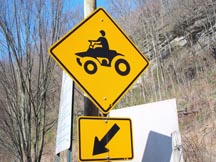 |
Matewan is also the site of one of the primary trailheads to the Hatfield and McCoy Trail System which offers hundreds of miles of trails throughout the mountains of West Virginia many of which travel along the old coal roads. |
|
|
|

